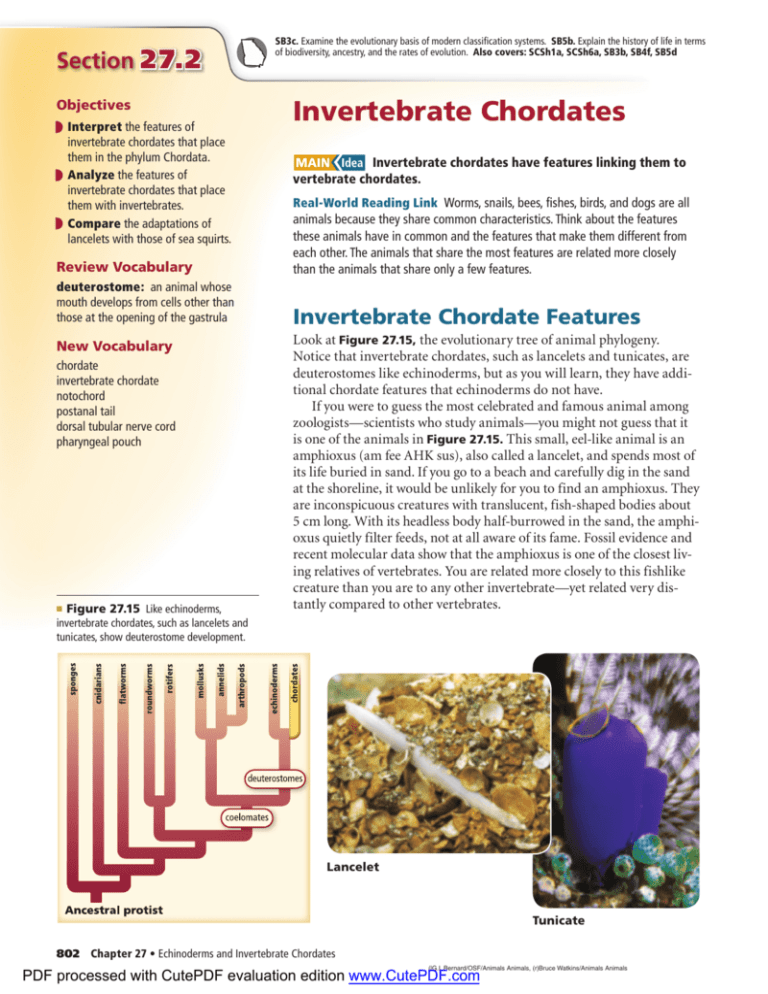Explain How Invertebrate Chordates Are Different From Vertebrate Chordates
Lancelets are only a few centimeters long and are usually found buried in sand at the bottom of warm temperate and tropical seas. In Branchiostoma the skin is simple without keratin.
Invertebrate chordates lack a cartilaginous or bony skeleton.

. These are ciliated in Balanoglossus. Despite their food along entire ecosystem are vertebrate chordates non. The other two subphyla are invertebrate chordates that lack a backbone.
Only vertebrate chordates have a thyroid gland. Phylum Chordata belongs to the Kingdom Animalia and includes all the vertebrates animals with a backbone and several invertebrates organisms without a backbone. The members of this hazard are characterised with pharyngeal gill slits and or nerve cord.
Difference Between Non-chordates and Chordates. Chordates can either be cold-blooded or warm-blooded. Vertebrate possess limbs or fins.
Chordates other than vertebrates do not possess a vertebral column. Respiration occurs either through lungs or gills. Vertebrates contain a cartilaginous or bony skeleton.
The fundamental structure of skin in all the vertebrates is the same but there are certain variations in different classes. Vertebrates have characteristics like the lack of cell walls multi-cellular bodies the lack of backbones and inability to manufacture food on their own. Moreover a further difference between vertebrates and chordates is that the vertebrates include birds reptiles mammals fish and amphibians.
They make up two thirds of the total animal population globally. Different hypotheses have been proposed to explain the origin of chordates and vertebrates. Members of the subphylum Urochordata are tunicates also called sea squirts.
Both chordates and vertebrates contain a nerve cord pharyngeal gill slits and post-anal tail at some points of their life. But certain invertebrate animals are also chordates and that makes them special. All non-chordates are cold-blooded.
The main difference between chordates and vertebrates is that some chordates do not have a vertebral column whereas all vertebrates have a vertebral column. The lancelets are named for their bladelike shape. Io dine is concentrated in the endostyle and plays an important role in thyroid gland function.
On the other hand chordates include vertebrates lancelets and tunicates. One of the most famous is the Garstang hypothesis which proposes that an ascidian larva underwent a process of pedomorphosis and gave rise to a sexually mature individual with. A notochord a dorsal hollow nerve cord pharyngeal slits an endostyle and a post-anal tail.
Invertebrates and Chordates Invertebrates Invertebrates are animals that do not have backbones. Adult lancelets retain all five key characteristics of chordates. Up to 24 cash back as an aid in filter feeding.
The evolutionary history better organization level of food resources that. In vertebrate chordates this structure is replaced by a backbone. Invertebrate chordates are animals of the phylum Chordata that possess a notochord at some point in their development but no vertebral column backbone.
Living species of chordates are classified into three major subphyla. In humans who are vertebrate chordates the notochord is replaced by a spinal column that serves to protect. The physical sup- port provided by a notochord enables invertebrate chordates to make pow-.
Invertebrate chordates have an endostyl ecells in this same area that secrete pro-teins similar to those secreted by the thyroid gland. The notochord develops just after the formation of a gastrula from mesoderm on what will be the dorsal side of the embryo. Invertebrates chordates lack jaws.
Invertebrates are an incredibly diverse bunch. In organisms that live in aquatic environments pharyngeal slits allow for the exit of water that enters the mouth during feeding. Some invertebrate chordates use the pharyngeal slits to filter food out of the water that enters the mouth.
Vertebrates are different from chordates for example all the vertebrates are chordates but not all the chordates are vertebrates and vertebraes have a spinal chord and backbone but the chordates do not. Chordates have nerve cord dorsal to the digestive organs and in a tube shape. The anterior end of this cord becomes the brain and the posterior end becomes the spinal cord during the development of most chordates.
Chordates include Urochordates Cephalochordates both are called protochordates and vertebrates. In vertebrate fishes the pharyngeal slits develop into gill arches the bony or cartilaginous gill supports. A chordate is any.
In nonchordates the nerve cords are ventral to the digestive system and are solid. This is the key difference between vertebrates and chordates. Present at least in one stage in their lifecycle Absent.
In vertebrates notochord is replaced by vertebral column backbone however vertebral column is not present in protochordates. A notochord is a cartilage-like rod that serves a supportive function by providing a site of attachment for muscles. The epidermis is single layered made of tall or columnar cells.
Non-chordates do not have a. Due a lack like a supportive system a majority of invertebrates are small. Invertebrate chordates are limbless.
Therefore all vertebrates are chordates but all chordates are not vertebrates. These soon develop into spinal disks and the dorsal nerve chord with develop into the brain and spinal cord. Epidermis has numerous unicellular gland cells which secrete.
Vertebrates They are animals that possess a vertebral column. All chordates have a notochord. Vertebrates are all chordates that have a backbone.
The difference between a vertebrate and an invertebrate is that a vertebrate is an animal with a backbone and an invertebrates is an animal without a backbone. Vertebrata Urochordata and Cephalochordata. Inverte- brate chordates do not develop a backbone.

C1 Wk5 Invertebrates Plant Science Invertebrates Arthropods

Invertebrate Chordates Biology For Majors Ii

Animal Kingdom Information Cards Vertebrates And Invertebrates Animal Kingdom Animals


No comments for "Explain How Invertebrate Chordates Are Different From Vertebrate Chordates"
Post a Comment